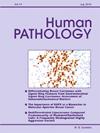Clinicopathological study of 34 cases of clear cell adenocarcinoma of the urinary tract and diagnostic value of SOX 17 in its differential diagnosis
IF 2.7
2区 医学
Q2 PATHOLOGY
引用次数: 0
Abstract
Clear cell adenocarcinoma (CCA) of the urinary tract is a rare tumor with a female predominance. The morphological features and immunoprofile of urinary CCA, CCA of the gynecologic tract (Gyn CCA), and nephrogenic adenoma (NA) can show extensive overlap, and the differential diagnosis can be challenging especially in small biopsies. SOX17 is a newly identified sensitive and specific immunomarker for endometrial and ovarian carcinomas including Gyn CCA. However, its expression in urinary CCA and NA has not been studied. We studied clinical and pathological features of 34 cases of urinary CCA, the largest cohort in the literature to date. We analyzed the expression pattern of SOX17 in a cohort of 34 urinary CCA, 24 Gyn CCA, and 18 NA. Interestingly, 29 % (10/34) of urinary CCA showed high SOX17 expression, while all the NA cases (18/18) showed negative-low expression. In female, 51 % of urinary CCA cases (15/29) show negative-low expression of SOX17, whereas all Gyn CCA (24/24) showed high SOX17 positivity. Our study showed a unique expression pattern of SOX17 in urinary CCA and NA. These results suggest that SOX17 is a useful marker in distinguishing CCA from NA or urinary CCA from Gyn CCA. Moreover, our study suggests different pathogenic pathways for the histogenesis of urinary CCA.

尿路透明细胞腺癌34例临床病理分析及sox17在鉴别诊断中的诊断价值
透明细胞腺癌(CCA)是一种罕见的肿瘤,以女性为主。泌尿CCA、妇科CCA和肾源性腺瘤(NA)的形态特征和免疫特征可以表现出广泛的重叠,鉴别诊断具有挑战性,特别是在小活检中。SOX17是一种新发现的子宫内膜癌和卵巢癌(包括Gyn CCA)的敏感和特异性免疫标志物。但其在尿CCA和NA中的表达尚未见研究。我们研究了34例尿CCA的临床和病理特征,这是迄今为止文献中最大的队列。我们分析了SOX17在34例泌尿CCA、24例妇科CCA和18例男性CCA中的表达模式。有趣的是,29%(10/34)的CCA患者SOX17高表达,而所有NA患者(18/18)均为低表达阴性。在女性CCA病例中,51%(15/29)为SOX17低表达阴性,而所有女性CCA病例(24/24)均为SOX17高表达阳性。我们的研究显示SOX17在尿CCA和NA中具有独特的表达模式。这些结果表明SOX17是区分CCA与NA或泌尿CCA与Gyn CCA的有用标记物。此外,我们的研究表明尿CCA的组织发生有不同的致病途径。
本文章由计算机程序翻译,如有差异,请以英文原文为准。
求助全文
约1分钟内获得全文
求助全文
来源期刊

Human pathology
医学-病理学
CiteScore
5.30
自引率
6.10%
发文量
206
审稿时长
21 days
期刊介绍:
Human Pathology is designed to bring information of clinicopathologic significance to human disease to the laboratory and clinical physician. It presents information drawn from morphologic and clinical laboratory studies with direct relevance to the understanding of human diseases. Papers published concern morphologic and clinicopathologic observations, reviews of diseases, analyses of problems in pathology, significant collections of case material and advances in concepts or techniques of value in the analysis and diagnosis of disease. Theoretical and experimental pathology and molecular biology pertinent to human disease are included. This critical journal is well illustrated with exceptional reproductions of photomicrographs and microscopic anatomy.
 求助内容:
求助内容: 应助结果提醒方式:
应助结果提醒方式:


